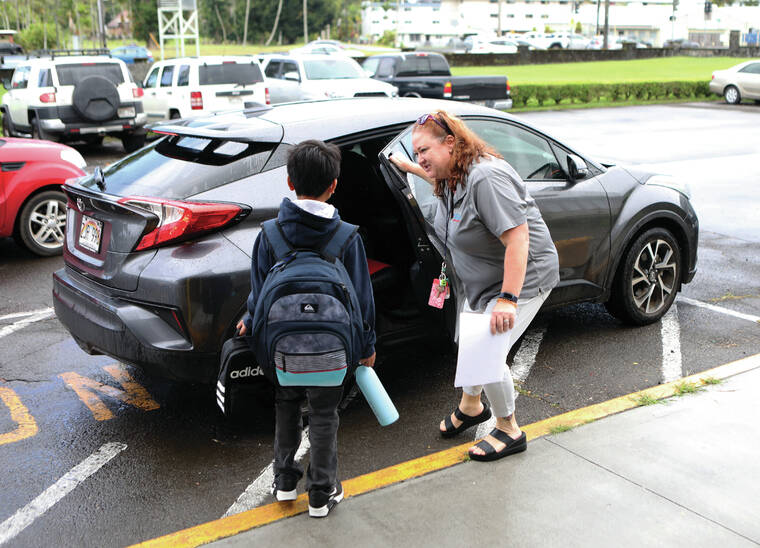Few Big Island schools have undergone vulnerability assessments meant to ID campus weaknesses
Despite an increase in threats reported at state Department of Education schools, just 14 of 41 Big Island campuses have completed a vulnerability assessment since 2017.
These include: Kalanianaole Elementary and Intermediate, Kapiolani Elementary, Kahakai Elementary, Kealakehe Elementary, Kealakehe High, Kohala High, Waikoloa Elementary &Intermediate, Keaau Elementary, Keaau Middle, Keonepoko Elementary, Mountain View Elementary, Naalehu Elementary, Pahoa Elementary and Pahoa High and Intermediate.
ADVERTISING
Four Big Island schools are scheduled for assessments this year: Holualoa Elementary, Kohala Middle, Ka‘u High and Pahala Elementary.
Just 116 assessments were completed statewide out of the DOE’s 258 schools, but assessments of all campuses reportedly will take place over the next three years.
“These assessments help identify weaknesses on school campuses and provide recommendations to mitigate those risks,” Superintendent Keith Hayashi said Jan. 10 during a DOE safety briefing. “Areas of weakness may include, for example, supervision during student transition periods, such as pickup and drop-off and recess, leveraging information technology resources to enhance security on campus, controlling entry and exit points, securing the perimeter around facilities (and) adding additional signage in high-traffic areas.”
Results of the assessments have not been released to the public, and redacted reports are available via formal request to the Department of Education.
When it comes to campus safety, Hayashi also noted the DOE has had trouble filling security guard positions.
“There are various types of security that schools may have for their campuses,” said DOE spokeswoman Krislyn Yano, who said the official number of security guards needed was not available. “Some schools have security personnel on staff, some have contracted security, and neighbor islands have School Resource Officers whose positions are funded by the respective county police departments.”
In 2019, there were 103 threats made at schools to students or staff. This number dropped to 47 during the pandemic in 2020. But as students returned in-person, threats rose to 124 in 2021 and to 152 in 2022.
“These range from vague to very specific, and all threats are taken seriously,” Hayashi said, adding the threats were made using social media, emails, graffiti, phone calls and other methods.
Concern among students also has risen in Hawaii, with the latest Youth Risk Behavior Survey reporting 12.4% of students did not go to campus on at least one day during a 30-day period because they felt unsafe at school or on their way to or from campus.
Nationwide during the 2022 school year, there were 332 shooting incidents on K-12 school campuses, the highest in four decades.
This has led more teachers to feel unsafe at school. Education Week reported four in 10 teachers feel less safe in their schools than they did five years ago, and six in 10 fear “purposeful mass homicide.”
But some Hawaii Island teachers believe the threat of school violence is more of a concern on the mainland.
“There’s always teachers who have concerns whenever they hear about something happening on the mainland, but especially on the Big Island, that’s very distant to us and not really a present concern or threat in our minds,” said Austin Morrissey, special education teacher at Honokaa Elementary. “At my campus, we feel very safe.”
Morrissey took part in active shooter training this year, which he said was helpful but slightly impractical.
“It was helpful in assuaging some worries people had,” he said. “But it’s not really practicable to do that with a bunch of 7-year-olds.”
Preventive training was also provided to roughly 1,000 DOE employees in June, July and December of 2022.
Edwin Kagawa, a social studies teacher at Keaau High, thinks security and training are only addressing the tail-end of an ongoing issue.
“I would like the focus not to be on these drills and trainings, but on prevention,” he said. “I wish that the DOE would provide more support to the students and schools. This could be in the form of additional counseling services, mental health services, and programs addressing bullying and violence.
“We are not going to solve these problems without getting to the root of the problem.”
Email Grant Phillips at gphillips@hawaiitribune-herald.com.
CORRECTION: A previous version of this article inaccurately stated that redacted vulnerability assessment reports were available via formal request to the Office of Information Practices for a fee of $7,142.50. The OIP does not maintain records of other agencies, does not maintain the vulnerability assessment reports, and has not received any requests for the reports. Record requests were made to the Department of Education under the State Uniform Information Practices Act for copies of the reports, but OIP was not involved with the requests and would not be involved unless someone seeks assistance or appeals to OIP.




